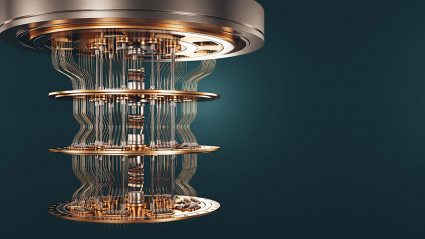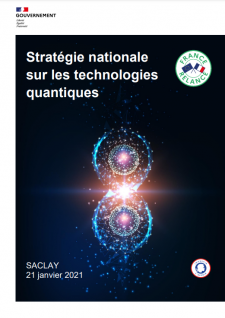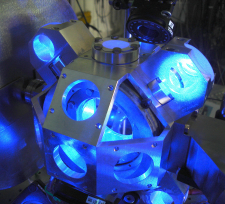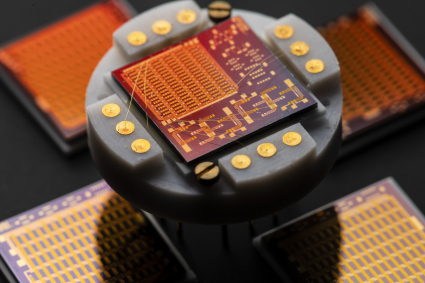
Discovered in the first half of the 20th century, quantum physics, the science of atoms and elementary particles, has never ceased to surprise and amaze physicists by its disconcerting nature. Today, it is in the process of being 'domesticated' and offers the promise of a technological revolution, the first benefits of which are beginning to spread outside the fundamental research laboratories. In order to make France a future heavyweight in a sector that is key to the sovereignty and economic competitiveness of states, President Macron presented a National Strategy on Quantum Technologies in January. LNE and its partners are fully involved in this strategy.
Computers so powerful that they would be able to predict in a few minutes the ideal conformation of a therapeutic molecule, the composition of a CO2-capturing material or to optimise motorway traffic on a territory; communication networks that are inviolable and at the same time the possibility of breaking any 'adversary' cryptographic code; ultra-sensitive sensors capable of anticipating from space the occurrence of floods, droughts or earthquakes... These are the promises of quantum technologies. Based on the exploitation of the laws of the infinitely small, they are beginning to spread outside the laboratories and now represent a crucial issue of sovereignty and competitiveness for all the major scientific and technical nations. On 21 January, President Macron presented the National Strategy on Quantum Technologies. With a budget of €1.8 billion, the aim of this plan is to set up an ecosystem capable of propelling France into the top tier of nations mastering these technologies. LNE and its partners are a key player in this plan.
The quantum computer: a physicist's dream come true

At the root of this revolution are the counterintuitive laws of quantum mechanics. Counterintuitive, to say the least. Within the microscopic universe, a particle, an atom or a grain of light can indeed be in several states or locations at the same time, but also compose so-called entangled objects, both composite and yet irreducible.
In the 1980s, the Nobel Prize-winning physicist Richard Feynman was the first to imagine how to take advantage of these disconcerting properties. Whereas in a classical computer, the units of information, the bits, take the values 0 or 1, he imagined a processor in which quantum corpuscles would play the role of 'qubit' capable of encoding both the values 0 and 1. The key to this was the possibility of massively parallel calculations, which would relegate, at least in principle, the most powerful computers of today to the rank of a simple calculator for solving a host of problems.
At first, this was just intuition. But as the years went on, several researchers have formally demonstrated the computational performance that such a computer would actually possess. In parallel, molecules in the liquid phase, ions trapped by laser beams, impurities in solids, superconducting circuits... various physical systems that are putative candidates for qubit status are being implemented in laboratories, right up to the experimental realisation of simple logical operations on 'mini quantum computers'.
As they gradually learn to manipulate microscopic objects whose properties are extremely sensitive to their environment, physicists realise that their research into quantum computing opens up unsuspected avenues for designing ultra-sensitive sensors. Finally, by managing to distribute quantum-entangled systems over very long distances, either by satellite or by optical fibre, they are laying the foundations for communications that are impossible to intercept by any eavesdropper. In short, the quantum revolution is underway.
In recent years, it has even taken a decisive turn with the entry of the digital giants into the fray. Admittedly, their sensational announcements about claimed quantum advantage are the subject of intense debate among specialists. But it is clear that it is now the quantum computer as such that is being targeted, just as it is the objective of all the major powers, led by the United States and China.
Making France a heavyweight in quantum technologies

For its part, France has some magnificent assets, starting with fundamental research laboratories at the highest world level, from which several Nobel Prize winners in physics have emerged. But also a handful of leading industrial groups (Atos, Thalès, Orange, Air Liquide, etc.) that have begun to mobilise, and a network of innovative start-ups including Pasqal, Alice & Bob, C12 Quantum Electronics, Quandela, and Qubit Pharmaceuticals.
In this context, the National Strategy represents "the key to being at least among the top three in the world", stated Emmanuel Macron during the announcement of this public-private investment plan which, over five years, should serve as a lever in the structuring of the French quantum ecosystem. The investments in this plan will be distributed as follows: 780 million euros for quantum computers alone, 320 for communications, 250 for sensors, 300 for enabling technologies such as cryogenics, electronics, lasers and materials, and 150 for so-called post-quantum cryptography.
Within this programme, metrology, and therefore LNE and its partners, notably the French National Metrology Network (RNMF), will play a key role. The deployment of a quantum metrology platform will be at the heart of this contribution. This platform should enable the implementation of R&D actions on the new generation of quantum measurement standards and their dissemination by taking advantage of the progress of quantum techniques, while at the same time providing solutions to the measurement needs linked to the development of these technologies. This second component could concern the development of suitable and validated measurement and characterisation tools and methods, the establishment of traceability chains, as well as their implementation... all of which should lead to the reliable measurement of performance that is essential for deploying a technology on an industrial scale and ensuring its competitiveness.
Metrology, a discipline at the crossroads of quantum technologies

LNE has a twofold legitimacy with regard to all these issues. Firstly, it is linked to its general expertise in measurement and the establishment of reference standards, but also because of its world-class expertise in quantum metrology.
Thanks to the accuracy and availability of its atomic clocks, LNE-Syrte alone carries out 40% of the primary calibrations used to define universal time at world level. The laboratory is also a pioneer in the development of so-called optical clocks, which should eventually replace the caesium clocks currently used to define the second.

As part of the SI redefinition adopted in November 2018, LNE's metrologists were also the first to propose a quantum measurement standard based on the quantum Hall effect and the Josephson effect to achieve the new definition of the ampere. They also implemented a graphene-based resistance standard with record accuracy and simplified experimental conditions for wider dissemination.
LNE's work on quantum measurement standards is a perfect example of how the development of quantum metrology feeds the synergy that should lead to the advent of quantum engineering. Working on graphene, for example, means working on a material with exceptional electronic properties that is of interest for certain quantum technologies, which means that some of the developments carried out at LNE are part of the 'enabling technologies' component of the National Strategy. In addition, the work on the quantum Hall effect in graphene, carried out with CEA-Saclay, opens the way to the development of quantum circuits that can be used to measure the states of an electron and manipulate them to create so-called 'flying' electronic qubits.
The past collaboration between the LNE and CEA-Grenoble on silicon nanowires offers another striking example. While the latter have been studied for a future single-electron current standard, it turns out that these devices also have physical properties that could make them qubits based on the electron spin. What is in it for them? These potential building blocks of a future quantum computer have the advantage of being compatible with the large-scale integration techniques developed in microelectronics.
Time metrology is in the same logic of cross-fertilization with research on quantum technologies. Specifically, thanks to the optical clocks currently being developed, metrologists imagine achieving a precision of 10-18 in the definition of the second, compared with 10-16 today with caesium atomic clocks. At this level of precision, however, we become sensitive to geodesic effects via the variation of the gravitational potential, effects that must be taken into account in order to achieve the targeted precision. But in return this means that an optical clock could become a quantum geodesic sensor accurate to the centimetre, according to the researchers' estimates.
Finally, we can also mention the work of LNE-CNAM in the field of temperature metrology. For example, in the context of the redefinition of the kelvin, in 2018, the laboratory developed an original acoustic thermometer that makes it possible to link the speed of sound in a gas to its thermodynamic temperature. Such a device or the optomechanical resonators on which the laboratory is working could also be used for the fine characterisation of the cryogenic conditions necessary for the realisation of a quantum computer.
With the National Quantum Strategy unveiled at the beginning of 2021, LNE and all the national research bodies, university laboratories, industrial partners and start-ups involved are beginning to organise themselves around the first metrology subjects identified. Although it is too early to communicate the details of the issues that will ultimately be addressed, French metrologists and their partners should be involved in developing standards for the measurement and the evaluation in all the technologies covered by the National Quantum Strategy, from sensors to quantum computers, including communication and cryptography systems, not to mention enabling technologies.
With this five-year plan, France is showing strong ambitions. Beyond that, it hopes to collaborate with other European countries, including Germany and the Netherlands, in order to make Europe the global centre of gravity of what is shaping up to be a real technological revolution.
[published in january 2021]





